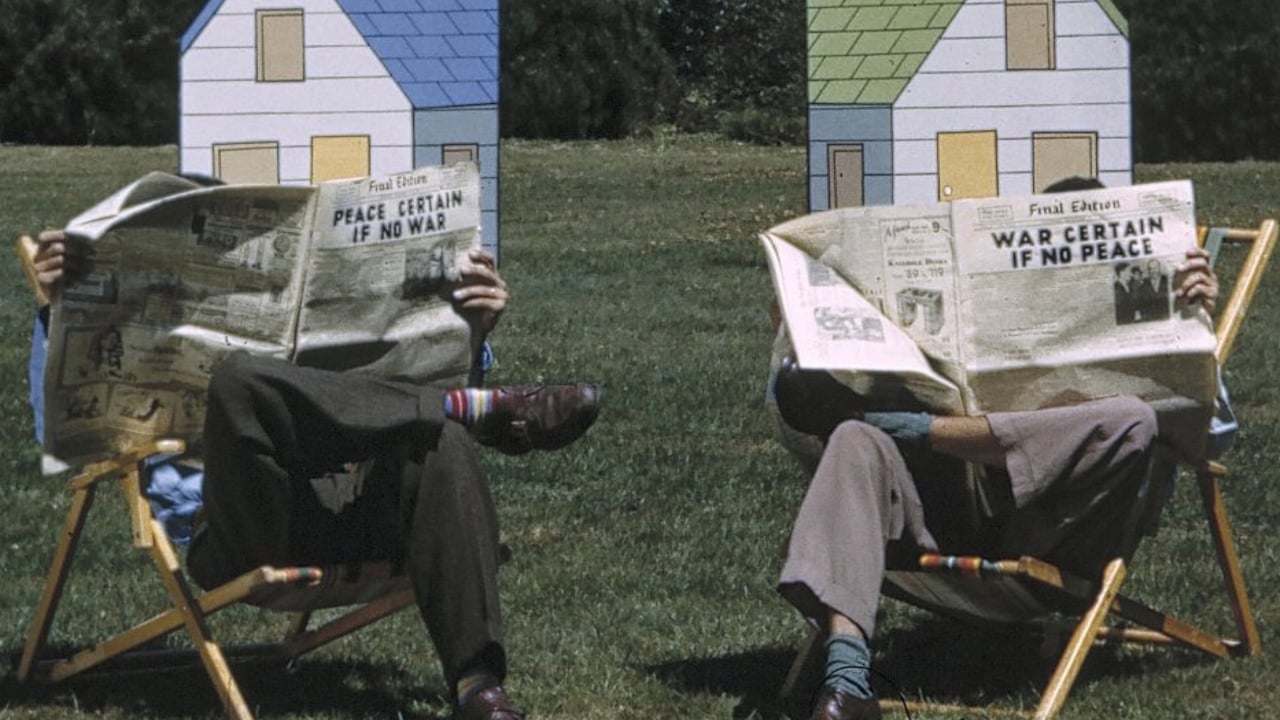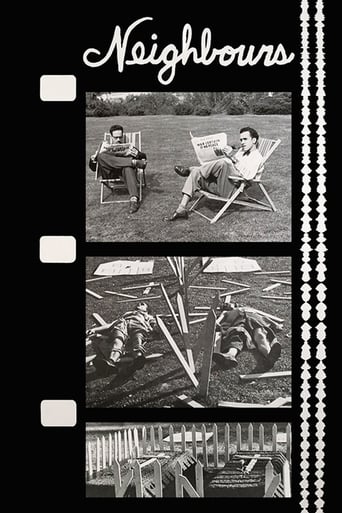



Some things I liked some I did not.
Most undeservingly overhyped movie of all time??
If you like to be scared, if you like to laugh, and if you like to learn a thing or two at the movies, this absolutely cannot be missed.
View MoreIt's a movie as timely as it is provocative and amazingly, for much of its running time, it is weirdly funny.
View MoreI have to say I don't mind Norman McLaren getting an Academy Award. I am generally not too big on his movies and that includes this one here, but he is sort of considered a legend in animation from the 20th century, so it's fine with me. That does not change, however, the way I perceived this short film here. It is in color, runs for 8 minutes and not only won the Academy Award, but was nominated in another category as well, something that is not possible today anymore, at least not for short movies. The entire film is about two men fighting for a flower which grows in their garden. First, the dispute is verbally, then it gets physical and in the end it is lethal. The story is too absurd for my taste already, which hurt my perception of this film and I felt that it dragged occasionally. Then again, this is the point as the actions by the two men are not human at all, but basically all special effects. One of the two was Grant Munro, a famous animation filmmaker himself and still alive in his 90s today. This short film from almost 65 years ago did not do a lot for me. Only worth a watch for those who want to see all short film winners from the Oscars. Everybody else is not missing much, even if this is maybe the most famous short film from the legendary NFB.
View MoreIn January 2007 I went to London expressly to attend part of a two-month long Luis Bunuel retrospective held at the National Film Theatre where I caught up with all but one of the remainder of his films. During that same period, a concurrent season of movies featuring Humphrey Bogart (on the 50th anniversary of his death) and Lauren Bacall and another one dedicated to Canadian animator Norman McLaren were also held. Although I am a fan of Animation in general, I was a bit wary of McLaren's work falling in the abstract branch of it but had always been interested in checking it out regardless since the late British film critic Leslie Halliwell deemed his best-known piece BEGONE DULL CARE (1949) worthy of his full **** rating. While the latter was indeed one of several shorts I managed to catch during that one particular evening, I cannot say I was sufficiently impressed to follow it up on my own time, as it were. Still, learning that 3 more films of his were nominated for the Best Short Subject Academy Award, I decided it was high time to reacquaint myself with McLaren's oeuvre given my ongoing Oscar marathon.The 8-minute short under review is the only one of the three to emerge victorious and deservedly so; bafflingly, this won in the Best Documentary Short category while also being nominated for Best Short Subject. The simple plot deals with two neighbors who spend a lazy afternoon basking in the sun and reclining on a chair reading newspapers in front of their respective house but, tellingly, the headlines of one newspaper is completely belied by the other's. Suddenly a flower spurts out from a seed sown right beneath their feet and, after their initial mutual admiration for it, each one lets greed get the better of him and both start claiming it as their own private property. This sets off a battle of wills that soon turns increasingly physical, irrationally violent and ultimately fatal for all three parties; the scene where one erects a barricade between the two houses enclosing the flower on his side of the fence while the other relocates the latter to his advantage or having the flower use its petals to, as it were, take cover from its battling masters adds a nice touch of Surrealism.However, the film's real coup comes at the end when, having trampled on the flower during their struggle, both men are overtaken by a feverish bloodlust that sees them enter each other's home and murder the occupants (a wife and a baby in both cases) through vicious kicking or throwing about! By this time, the violent men have adopted Indian warpaint on their faces and, when they eventually expire, the once-important white fence is transformed into crosses on each respective grave that have been dug where the houses used to stand. With time, more flowers bloom both on the graves themselves and on the earth surrounding them. The end titles, then, is an animated collage of the phrase "Love Thy Neighbor" in various languages. Although the film was originally issued sporting a monotone electronic score by McLaren himself (also available on "You Tube"), I elected to watch it accompanied by a score (recorded in 2010) by an obscure outfit named Versa that very effectively counterpoints the on screen action.
View MoreTwo neighbours sit opposite one another reading the same paper, smoking the same pipes and enjoying their property and lives. Things get even better when a beautiful flower grows in the middle of the joint garden that both men love for its appearance and aroma. However when they both try to appreciate the flower at the same time a minor squabble starts up regarding ownership of the flower and soon the conflict spirals out of control.I watched this short film after having it mentioned in discussions on classic short films I should see as part of trying to see more films than just the blockbusters that Hollywood kicks out month after month. Watching it more than fifty years after it was made I was surprised by how fresh it did feel. Of course it is still relevant, which is not really down to Maclaren but more down to the nature of man I think but the plot does still work. Modern viewers might feel that it runs a little longer than it should and it is pretty obvious in what it is saying and this was a quibble for me but not a deal breaker. What carried this simple morality tale was the animation, which is stop-motion but still feels fun and creative now.Using live things to do stop motion must be pretty difficult it is a time consuming and painstaking process with clay and things (that can be kept still when you need them to be) but with humans that can lose position it is more challenging. Credit to Maclaren that it looks great and flows really well throughout. A classic short then even if it is not perfect. The simple message is laid on pretty thick and is not as smart as some would say but it is still smart enough to hold it together while the animation feels fresh and inventive.
View Morenorman mclaren's neighbours is a masterpiece of animation- it entertains, educates, and satirizes, all at once.the plot of the film is simple, and predictable: two neighbours are fighting over a flower, which seems to fall directly between their two properties. naturally, the two fight over the flower until both they and the flower are destroyed.however, underneath that simple plot, there lies a strong anti-war message. it points out that war does not allow for winners, only losers; and it reminds us that we've been known to forget why, exactly, we're fighting each other, killing each other, as well as each other's families.the battle is shown with live-action/stop-go animation- which allows the effects of the flower on the two men to be exagarrated easily. this suits the film well, giving a serious topic a little light-heartedness.an interesting side-note- the soundtrack was not recorded, but rather hand-painted (by mclaren himself) onto the soundtrack. this gives the soundtrack a boxy, nintendo-like quality.in my mind, this film could sit easily with modern anti-war classics; never too preachy, never too simple.truly enjoyable.
View More